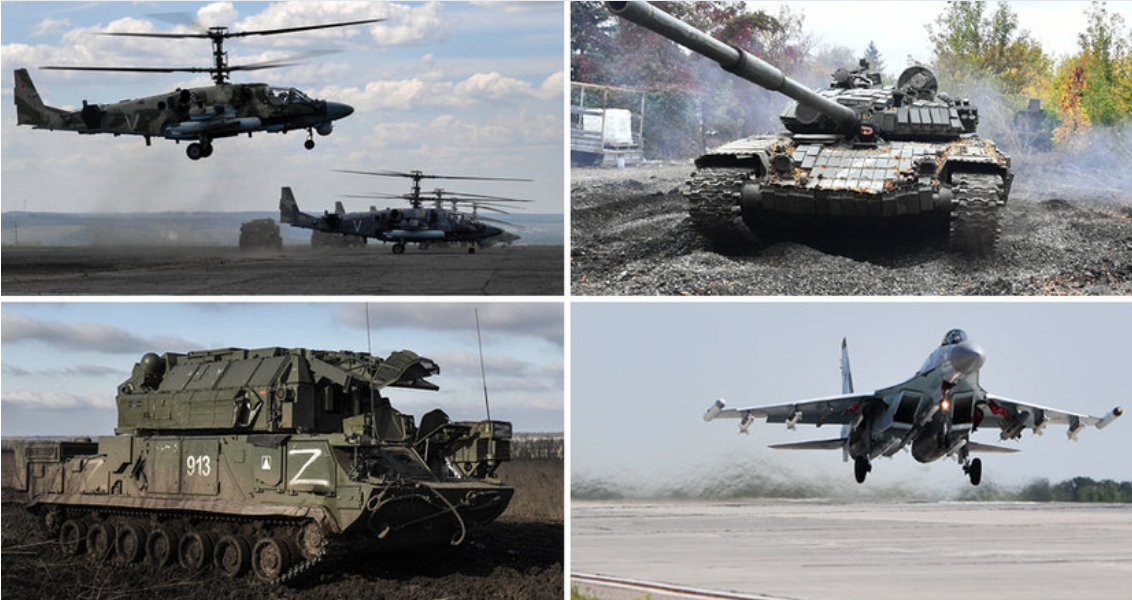-
Seven Reasons Why Russia Dominates in Ukraine

There have been little to no at least somewhat objective assessments of Russia’s special military operation (SMO) in Ukraine, primarily due to the fact that our newsfeeds are being flooded with an ocean of ludicrous propaganda that only aims to portray Moscow’s forces as supposedly “weak and ineffective”. Everyone from tabloids and YouTube “experts” to reputable (or rather once reputable) media keep parroting the same narrative – “Russia is losing“. However, is that the case? Here are seven reasons why that’s not only patently false, but quite the opposite, it couldn’t possibly be further from true.
Unrivaled Command and Control
The Russian Armed Forces, as one of the largest and most powerful on the planet, are a massive and complex system. And yet, this system is characterized by centralized control that allows the Russian High Command to respond to changes on both tactical and strategic levels in a timely and adequate manner. The Eurasian giant’s military has massive reserves that are orders of magnitude greater than the forces deployed on the frontlines. These can easily be relocated to areas that need to be reinforced while also providing additional assault troops that can be inserted in areas where the enemy’s defenses are the weakest.
Perhaps the best example of this is the recent advance of Russian troops in northern Donbass and the border areas between the LNR (Lugansk People’s Republic) and the Kharkov oblast (region), where Moscow’s forces have been on the offensive for over two weeks. Despite the fact that the now heavily battered Kiev regime troops have constantly been losing ground in this area, there’s been virtually no mention of this in any of the mainstream propaganda outlets. In the meantime, the Neo-Nazi junta’s best forces are wasting their last battlefield reserves in futile attacks on the intricate and dense Russian defenses in the Donbass, Zaporozhye and Kherson oblasts.
And while the mainstream propaganda machine keeps denigrating the Russian military, behind the scenes, the Pentagon meticulously observes Russia’s advanced experience in organizing command and control systems and how it can use it to improve its own. Moscow’s ability to lead multiple high-intensity military operations simultaneously while coordinating all this with the rest of Russia’s massive state apparatus (particularly its world-class diplomacy) is of great interest to power circles in Washington DC. In stark contrast, the United States military is experiencing an unraveling of sorts due to issues with over-politicization and ideology.
Massively Improved ISR (Intelligence, Surveillance, Reconnaissance)
In years before the SMO, the Russian military wasn’t exactly known for the widespread use of drones and other unmanned platforms, as the mainstream propaganda machine kept presenting Moscow’s forces as supposedly “technologically inferior”. Still, years before the SMO, particularly during its antiterrorist intervention in Syria, the Kremlin invested significant resources in various kinds of unmanned systems. The Russian military then used this experience to massively improve its tactical capabilities, an effort that has exponentially amplified its performance everywhere. This is particularly true for the SMO, as drones have been an unrivaled force multiplier for Russian forces.
And while the Kiev regime forces are vastly superior to NATO-backed terrorists in Syria and elsewhere, and despite the fact that the belligerent alliance is providing them with unprecedented amounts of real-time battlefield information, for the most part, they’ve been unable to capitalize on this massive boost. Although tactical ISR by the Neo-Nazi junta troops is greatly augmented by NATO’s strategic one, better results on a larger scale have been sorely lacking. In contrast, the Russian military’s land, air and space-based ISR platforms have been used to a deadly effect, inflicting irretrievable losses on both enemy frontline troops, as well as its rear.
A Unique Combination of Active Defense and Ad Hoc (Counter)offensive Operations
Although doctrinally offensive-oriented, the Russian military certainly doesn’t neglect its defenses. On the contrary, it’s using its tactical defensive potential for strategic offensive purposes. The speed with which Moscow’s forces have been able to build up massive and complex defensive lines where there were none before has left NATO military experts baffled. The Soviet concepts of “defense in depth” and “active defense” have been greatly improved by the Russian military’s recent technological advances. This has resulted in nearly complete obliteration of the Kiev regime’s offensive potential, forcing it to use desperate tactics to try and break through Russian lines.
Needless to say, this is causing massive casualties in the process, as the Neo-Nazi junta forces are losing hundreds of men for every square kilometer of territory they take. However, the real issue for Kiev is that it can’t hold these areas for long, as each one effectively acts as an artillery “mousetrap”. Namely, as soon as the Kiev regime forces move in to secure the area, they’re pounded by a massive barrage of regular and rocket artillery, followed by a swarm of various types of drones that pick off any survivors. In addition, the masterful use of mines (particularly through remote mining) by Russian forces has been unequivocally devastating for any offensive operations.
This is particularly true in the Zaporozhye sector, where the Neo-Nazi junta forces continue to suffer massive casualties. Ever since the initial stages of their much-touted counteroffensive, these forces have experienced losses of over 30%, both in manpower and weaponry without ever seeing enemy combatants or even reaching the first line of Russian defenses. This has resulted in little to no losses for Moscow’s forces, particularly when considering the scale of military operations. Even the Chairman of the Joint Chiefs of Staff of the US Armed Forces, General Mark Milley, was forced to admit that the Pentagon is stunned by the effectiveness of these defense lines.
The High Morale of Russian Forces
The way that Russian defenses are able to hold has a devastating effect on the morale of Kiev regime forces while boosting their own. During the planning phase, the Neo-Nazi junta and their NATO handlers were confident that it would be easy to break through Russian defenses due to their supposed “low morale”. However, the reality on the battlefield shows that such assertions are wholly limited to the mainstream propaganda machine’s “parallel universe” in which even goats and old ladies “armed” with pickle jars are “beating the Russian military”. Still, unlike the mythical “massive Russian casualties”, such miscalculations have resulted in very real losses for Kiev.
Disorder, Insubordination and Inadequate Coordination Among Kiev Regime Forces
All of the aforementioned issues are virtually omnipresent in the ranks of the Neo-Nazi junta forces, as well as the numerous NATO-sourced mercenary groups. As the commanding cadre often sends troops to certain (and pointless) death, military personnel often ignore orders or outright refuse to follow them. Officers usually remain hidden in trenches or are even completely absent from the frontlines. This results in widespread frustration among soldiers, many (if not most) of whom are forcibly conscripted, which further leads to the low authority of the officers. This has also been confirmed by numerous foreign mercenaries fighting on the side of the Neo-Nazi junta.
Namely, in an interview for ABC, an Australian national known by the call sign “Bush” complained about the lack of necessary command and leadership skills among officers of the Kiev regime forces. According to his assessment, this issue has led to the deaths of both regular soldiers and foreign mercenaries. In addition, these men are often not following even basic orders, such as the complete ban on the use of smartphones on the battlefield. This offense is very common among soldiers and mercenaries alike, despite the fact that it’s virtually a death sentence in an era of warfare where SIGINT (signals intelligence) is an integral part of any meaningful military operation.
Top-notch Training and Combat Experience
The level of combat experience and training on both sides of the conflict is high, but differs significantly. While the conflict in the Donbass region has been going on for nearly a decade now, between late 2015 and late 2021, it was relatively low-level as the frontline stabilized and was mostly limited to artillery duels (although the shelling of Donbass never stopped). This has resulted in a largely superficial combat experience for most Kiev regime soldiers. On the other hand, the Russian military has accumulated significant combat experience in Chechnya, Georgia and Syria, where it had the chance to conduct complex operations against various opponents.
No amount of no matter how advanced NATO-sourced weapons and endless forced mobilization waves could’ve ever given the Neo-Nazi junta the necessary combat experience to adequately face Russian forces. This primarily refers to the strategic aspect of warfare, a field which Russian officers have been able to master as their military can deploy to virtually any point anywhere in the world, on-demand, and then set up strategically important military bases, even on an ad hoc basis. Syria is perhaps the best example of this, as demonstrated by Russian bases in Tartus (previously a small naval facility) and Khmeimim (an airbase established in 2015).
Vast Technological Superiority
Despite all the propaganda fantasies of NATO-supplied SAM (surface-to-air missile) systems shooting down Russian hypersonic weapons, even Western military experts are forced to recognize Moscow’s superiority in a plethora of long-range, high-precision weapons. In this regard, Russia’s absolute dominance in hypersonic technologies is just the icing on the cake, as the Kremlin boasts a no less impressive arsenal of more conventional strike capabilities that include (but are not limited to) various supersonic, transonic and hybrid land and sea-based cruise missiles, tactical ballistic missile systems, numerous types of kamikaze drones/loitering munitions, etc.
The latter have been used to a devastating effect, neutralizing thousands of Kiev regime’s artillery pieces, including hundreds of US-supplied M777 howitzers. ZALA’s “Lancet” and “Kub-BLA” have been particularly deadly in this regard, in addition to the mass usage of various types of FPV (first-person view) drones. Apart from these, the performance of Russian combat vehicles has vastly outmatched any NATO-supplied equivalents, regardless of how new and modern. In fact, even Soviet-era tanks and armored vehicles have proven to be superior to virtually any new Western vehicle in the same class, be it in the service of Moscow’s or Kiev’s forces.
Newer Russian tanks such as the T-72B3M, T-80BVM, T-90A and T-90M (as well as numerous types of armored vehicles), have all demonstrated stellar performance in comparison to the best NATO armor, particularly the now deeply troubled German “Leopard 2” tanks, including the latest A6 variant. The Neo-Nazi junta’s “wunderwaffen”, used in its abortive attempt to conduct a “blitzkrieg” counteroffensive, have been effectively useless. The combination of the use of all of the aforementioned assets (in addition to its unrivaled attack helicopters) has made it possible for Moscow to comfortably break wave after wave of Kiev regime attacks.







Login or Register to Leave a Comment